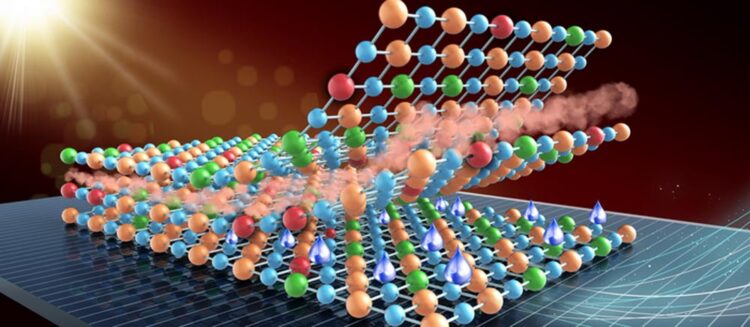High-performance large-area perovskite submodules for solar cells

Surface redox engineering of vacuum-deposited NiOx for top-performance perovskite solar cells and modules
Credit: DICP
Perovskite solar cells (PSCs) are promising solar technologies. Although low-cost wet processing has shown advantages in small-area PSC fabrication, the preparation of uniform charge transport layers with thickness of several nanometers from solution for meter-sized large area products is still challenging.
Recently, a research group led by Prof. LIU Shengzhong from the Dalian Institute of Chemical Physics (DICP) of the Chinese Academy of Sciences (CAS) has developed a facile surface redox engineering (SRE) strategy for vacuum-deposited NiOx to match the slot-die-coated perovskite, and fabricated high-performance large-area perovskite submodules.
This work was published in Joule on July 21.
Inverted PSCs are potentially more valuable than their normal counterparts because the former have easily-mitigated hysteresis behavior and long-term durability. NiOx has been demonstrated as the hole transport materials for inverted PSCs. But for most vacuum-processed NiOx films, the relatively hydrophobic surface attenuates the adhesion of perovskite ink, making it challenging to deposit large-area perovskite films.
Moreover, the surface chemistry of NiOx is rather complex as a large number of high-oxidative-state Ni species and chemically reactive hydroxyls can decompose perovskites, leading to an interface energy barrier and noncapacitive hysteresis.
The SRE strategy not only eliminates the local de-wetting problem of perovskite ink, thus achieving uniform polycrystalline perovskite films at the decimeter level, but also imparts enhanced performance in electronic properties, stability, mechanical adhesion at the buried interface via modulating the NiOx surface features.
In this study, the researchers achieved high-performance PSCs with stability of thousands of hours under various stressed conditions and outstanding photovoltaic performance. The power conversion efficiencies of PSCs were 23.4% and 21.3% for rigid and flexible devices, respectively.
Furthermore, due to the scalability of SRE strategy to large-area configurations, they assembled perovskite submodules of area 156 × 156 mm2 with a remarkable efficiency of 18.6% along with negligible hysteresis and good stability.
“The SRE strategy provides a proof of concept for combining vacuum-fabricated charge transport layers with wet-processed perovskites and facilitates the stacking engineering of large-scale, uniform thin films for the development of efficient and stable perovskite modules,” said Prof. LIU.
Journal: Joule
DOI: 10.1016/j.joule.2022.06.026
Method of Research: Commentary/editorial
Subject of Research: Not applicable
Article Title: Surface redox engineering of vacuum-deposited NiOx for top-performance perovskite solar cells and modules
Article Publication Date: 21-Jul-2022
Media Contact
Jean Wang
Dalian Institute of Chemical Physics, Chinese Academy Sciences
wangyj@dicp.ac.cn
Office: 41182464221
All latest news from the category: Power and Electrical Engineering
This topic covers issues related to energy generation, conversion, transportation and consumption and how the industry is addressing the challenge of energy efficiency in general.
innovations-report provides in-depth and informative reports and articles on subjects ranging from wind energy, fuel cell technology, solar energy, geothermal energy, petroleum, gas, nuclear engineering, alternative energy and energy efficiency to fusion, hydrogen and superconductor technologies.
Newest articles

Can lab-grown neurons exhibit plasticity?
“Neurons that fire together, wire together” describes the neural plasticity seen in human brains, but neurons grown in a dish don’t seem to follow these rules. Neurons that are cultured…

Unlocking the journey of gold through magmatic fluids
By studying sulphur in magmatic fluids at extreme pressures and temperatures, a UNIGE team is revolutionising our understanding of gold transport and ore deposit formation. When one tectonic plate sinks…

3D concrete printing method that captures carbon dioxide
Scientists at Nanyang Technological University, Singapore (NTU Singapore) have developed a 3D concrete printing method that captures carbon, demonstrating a new pathway to reduce the environmental impact of the construction…



